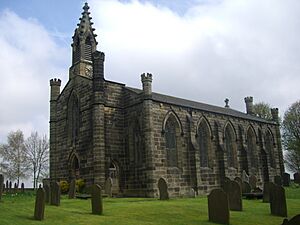Christ Church, Stannington facts for kids
Christ Church is an Anglican church located on Church Street in Stannington, Sheffield, England. It was built a long time ago, partly with money from a special government grant, which is why it's sometimes called a "Million Church." This church is also a Grade II listed building, meaning it's an important historical structure.
Contents
The Story of Christ Church
Building the Church
The construction of Christ Church finished in 1830. Architects Woodhead & Hurst from Doncaster designed the building. Plans were drawn up in 1827, and the first stone was laid on October 16, 1828. This important ceremony included William Hurst, one of the architects, who was also the Mayor of Doncaster.
The church cost about £3,000 to build. Some of the money came from a government grant called the Church Building Act of 1824. A large donation also came from Eliza and Ann Harrison of Weston Hall. Their father, Thomas Harrison, was a famous sawmaker in Sheffield.
Early Leaders and Parish Changes
When it was first built, Christ Church was part of the Bradfield area. Stannington did not become its own separate parish until 1843.
At first, the church did not have its own vicar. Instead, a curate named Mr. William Gill led the services. He lived in Bradfield, about three miles away. Mr. Gill conducted a morning service for six years. He left in 1836 when he was asked to also perform an evening service.
After this, a vicarage (a house for the vicar) was built next to the church. A salary of £100 per year was also provided for the vicar. In 1843, Stannington became its own parish, and Christ Church became the main parish church. William Gill returned as the first vicar, and his salary increased to £129 per year.
Over the years, many notable vicars have served Christ Church. Francis Augustine Stebbing was the longest-serving vicar, from 1916 to 1963. Canon Philip West was the vicar for over 20 years before he retired. In September 2014, Tim Fletcher became the Priest in charge. Then, on January 23, 2023, the Reverend Nicholas Lattimer became the Priest in charge, and he serves the church today.
Church Design and Special Parts
Outside the Church
The church is built from rough gritstone blocks. It has a balanced Gothic style, which is a type of architecture from the Middle Ages. There is a low, square bell tower with a weather vane on top. Below the weather vane, there is a three-faced clock and louvres (slanted openings).
Some interesting features on the outside are the seven turrets. These are small towers with battlement tops, like those on a castle. They stand on top of the corner piers. The lychgate, which is a covered entrance to the churchyard, was built in July 1940. Rebecca Nichols built it to remember her husband, John, who passed away in 1914. The graveyard was made larger in 1919, but it is now almost full.
Inside the Church
The outside of the church has changed very little over time. However, the inside has been rearranged several times. Originally, there was seating for 1,000 people, but this has been greatly reduced. Two long side balconies were removed in 1964 because they made the church very dark. A third balcony still remains along the back wall. This balcony once held the organ, and the choir used to sing from there.
The original font, used for baptisms, was brought from Bradfield in 1927. It was replaced by the Angel Font in July 1945. The original font was then placed outside in the churchyard, but sadly, it was stolen in 2001.
A major renovation of the inside happened in 1992 and 1993. The old pews were removed and replaced with chairs. A new floor was laid and carpeted throughout the church. The church's electrical wiring was also updated. At the same time, a new vestry (a room for clergy) was added. The baptismal font was moved to the front of the church. The baptistery area at the back was made larger to create a narthex, which is an entrance hall. A large open space was also created at the front by removing the choir stalls. The interior also has a wooden roll of honour. This lists the 70 people from the parish who died in the First World War.
See also


